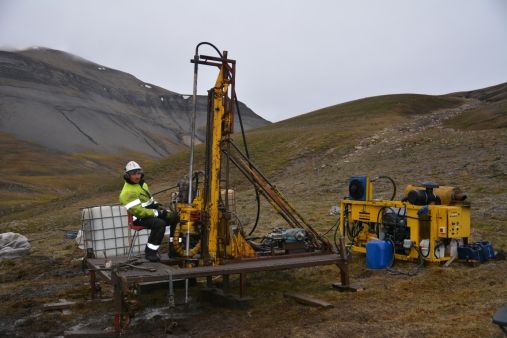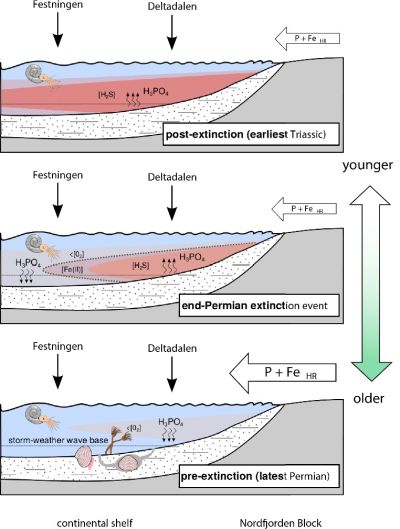Although the mass extinction that annihilated the dinosaurs at the end of the Cretaceous period is the most famous one, the end-Permian mass extinction is definitely the most catastrophic crisis in the history of life on Earth. Nicknamed “The Great Dying”, it saw approximately 81 percent of species disappear in the oceans and 75 percent of the species on land. The chain of events that led to this dramatic loss of life started with another extreme event: the development of the Siberian Traps Large Igneous Province. Not only did millions of square kilometers get covered by lava, but the incipient intrusions of magma into coal, anhydrite, and gypsum strata in the subsurface released tons of greenhouse and other poisonous gases into the atmosphere. The Siberian Traps triggered a global climate change, accompanied by a depletion of oxygen in the oceans, with dramatic consequences.
The end-Permian mass extinction (ca. 251.9 million years ago) had probably a prolonged lead-up of change that eventually reached a critical threshold. The crossing of this threshold caused a rapid worldwide extinction that eliminated more than 80 percent of all species”.
Despite the end-Permian mass extinction being extensively studied, the exact mechanism linking an eruption on land to the demise of life that lives in the sea has remained, however, controversial. “It is well known that the demise of the Dinosaurs was likely caused by instantaneous environmental destruction when the Earth was struck by an asteroid. In contrast to this ‘sledgehammer’ effect, the end-Permian mass extinction (ca. 251.9 million years ago) had probably a prolonged lead-up of change that eventually reached a critical threshold. The crossing of this threshold caused a rapid worldwide extinction that eliminated more than 80 percent of all species”, says lead author Dr. Martin Schobben.
----
This new study analysed two geological sections in Svalbard: one at Festningen in western Spitsbergen, and a core that Sverre Planke and his team (University of Oslo/Natural History Museum in London) recovered from Deltadalen in central Spitsbergen (see photos of the river above and the drill rig below). Schobben and his co-authors demonstrated that the element phosphorus plays a central role in linking these events. The authors assume that volcanism and the associated increased phosphorus input from the land preceded the extinction event.
The development of oxygen-poor shallow marine regions effectively removed phosphorus from seawater, and this was what prevented a massive catastrophe. However, the actual disaster was now only delayed and did not occur until a critical threshold was reached (see model below), so that the previous efficient removal of phosphorus came to a halt. In this new state, the phosphorus was recycled more effectively, causing the system to spiral out of control, increasing oxygen consumption and the accumulation of lethal hydrogen sulphide.

This new view of the cascade-like environmental destruction at the end of the Permian allows for a lengthy sequence of events - initially with only slight changes, but eventually building up to the final catastrophe.
The insights also offer a way to answer why certain organisms fared better than others during the extinction event. As the oxygen-depleted regions spread from the continent out to the open ocean,

the deep water sites possibly offered suitable habitats for organisms that could disperse and recover more easily than others.
"This research showed that extreme climate warming can cause large-scale environmental devastation if pushed beyond a key threshold, and the detrimental impact on marine life can be predicted with important lessons for projected climate warming", says second author Will Foster.
“Our new study demonstrates the dramatic consequences initiated by large scale volcanism, with a severe effect not only on land, but in the oceans as well, says Henrik H. Svensen at the University of Oslo.
Scientific article:
Reference: Martin Schobben et. al. (2020). A nutrient control on marine anoxia during the end-Permian mass extinction, Nature Geoscience: https://doi.org/10.1038/s41561-020-0622-1.
Co-authors from the University of Oslo:
Sverre Planke, Henrik H. Svensen, Valentin Zuchuat and Arve R.N. Sleveland.
For more information, contact:
Henrik H. Svensen at hensven@geo.uio.no
----
For further information about Svalbard during the end-Permian, see our recent paper:
Zuchuat, V., Sleveland, A.R.N., Twitchett, R.J., Svensen, H.H., Turner, H., Augland, L.E., Jones, M.T., Hammer, Ø., Hauksson, B.T., Haflidason, H., Midtkandal, I., Planke, S. (2020). A new high-resolution stratigraphic and palaeoenvironmental record spanning the End-Permian Mass Extinction and its aftermath in central Spitsbergen, Svalbard. Palaeogeography, Palaeoclimatology, Palaeoecology, https://doi.org/10.1016/j.palaeo.2020.109732.
